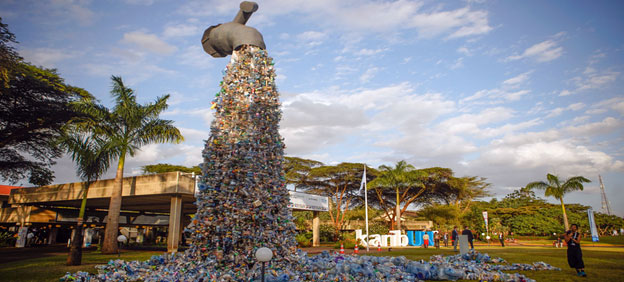
Civil Society, Climate Change, Development & Aid, Environment, Featured, Global, Headlines, Human Rights, Sustainable Development Goals, TerraViva United Nations

The Sustainable Development Goals (SDGs) are off track. Decades of progress on poverty and hunger have stalled, and in some cases, been thrown into reverse. Many developing economies are mired in debt, with financing challenges preventing the urgently needed investment push in the SDGs, according to the United Nations. But amid these challenges there lies opportunity. The Fourth International Conference on Financing for Development (FfD4) – 30 June to 3 July 2025–provides a unique opportunity to reform financing at all levels, including to support reform of the international financial architecture. Credit: United Nations
– When world leaders gather in Seville for the 4th International Conference on Financing for Development (FfD4) in June, they will be meeting at a pivotal moment: one defined by mounting systemic risks, a multiplication of crises, and proliferation and fragmentation of development co-operation actors and funds.
International development co-operation is also threatened by the ongoing erosion of funding, including through unilateral decisions of unparalleled magnitude. While momentum for reform and transformative change to the financial and development architecture is growing, it is crucial not to lose sight of the fundamentals.
To achieve the Sustainable Development Goals (SDGs), increases in the quantity of development financing, be it official development assistance (ODA), private finance, or South-South co-operation, must be complemented with boosting the quality of all types of financing so that they are delivered and used in the most effective way.

Credit: Nuthawut Somsuk
Efforts to increase the quality of financing are embodied by the development effectiveness agenda and its internationally agreed principles: country ownership, focus on results, inclusive partnerships, and transparency and mutual accountability. The principles are tried and tested, and more relevant than ever.
They build on and reflect decades of global experience and are increasingly crucial for addressing the challenges that characterize today’s development co-operation landscape, such as fragmentation and misalignment with country priorities. They are also key for mobilising different types of finance from a growing array of development partners and partnerships.
Yet, as the development landscape has increased in complexity in the years after the 2015 Addis Ababa Action Agenda, the systematic focus on development effectiveness at country level has not been adequately integrated into country ecosystems and ambitions. For instance, Integrated National Finance Framework (INFF) processes could be better utilized as opportunities to talk about development effectiveness.
As Co-Chairs of the Global Partnership for Effective Development Co-operation, we believe that development effectiveness is essential to mobilising financing for sustainable development, across all types of international co-operation for development. The FfD4 Outcome Document must clearly stress this point.
A stronger, more systematic focus on the benefits of development effectiveness – and on addressing the bottlenecks and trade-offs that hinder progress on the 2030 Agenda and SDGs – is essential to reinstate trust, increase financing for development, and achieve long-term positive impacts.
The four principles of effective development co-operation remain the core enablers of development effectiveness. We welcome the focus of the recently released FfD4 Zero Draft Outcome Document on country leadership, coherence, and mutual accountability, but reiterate the need to uphold past commitments originating from the long-lasting aid effectiveness and development effectiveness processes.
It is important for the Outcome Document to stress the continued validity and intertwined nature of the four effectiveness principles, including the role of inclusive partnerships and of civil society organizations in particular.
The involvement of all stakeholders – partner countries, development partners, the private sector, civil society, parliamentarians, philanthropies, and trade unions – remains central to the effectiveness agenda. It is also important to focus on the effectiveness of partnerships with the private sector, in particular by creating enabling environments for a local private sector to thrive, an area monitored by the Global Partnership through the Kampala Principles Assessment.
Effective private sector partnerships are key for ensuring transparency and accountability and for combatting corruption. A whole-of-society approach is key to achieving true country ownership, which has emerged as a central theme in the FfD4 negotiations.
How can the Global Partnership and development effectiveness contribute to FfD4 and its follow-up?
First, the Global Partnership Monitoring Exercise provides evidence to inform how development actors can improve their policies, practices and partnerships, insights into progress in implementing the agreed effectiveness commitments, as well as opportunities for learning, dialogue and sharing of experiences on emerging effectiveness challenges.
The monitoring is a partner-country led tool holding development stakeholders to account for their implementation of the commitments, and a starting point for concrete action and behaviour change. Since 2011, 103 partner countries have led the monitoring exercise one or more times in collaboration with over 100 development partners and other actors. The ongoing global monitoring round will bring new evidence into the discussions on effectiveness, including in the lead-up and follow-up to FfD4.
(Read preliminary observations from the first 11 countries to complete data collection: Bosnia and Herzegovina, Burkina Faso, Cambodia, the Democratic Republic of Congo, Indonesia, Lao People’s Democratic Republic, Nepal, the Philippines, Uganda, Yemen and Zambia).
The fresh insights from the monitoring round are one important source of evidence which will feed into country-led multi-stakeholder action for how to enhance effectiveness.
Second, the Global Partnership’s 4th High-Level Meeting (HLM4) in 2026, where the monitoring results will be presented, is the next crucial moment after FfD4 to take stock of development effectiveness, accelerate progress, drive accountability, and inform policy dialogue on international development co-operation trends.
We invite all development stakeholders to contribute to HLM4, and to act on the dilemmas, tensions and trade-offs we are all facing to expedite delivery of the 2030 Agenda. Strengthening and streamlining the development co-operation architecture must be a collaborative, inclusive process.
The Global Partnership offers a proven, multi-stakeholder platform to ensure that all voices are heard in shaping the future of development co-operation.
We invite you to join forces with us: raise the profile of development effectiveness in the lead-up and follow-up to FfD4, and use the monitoring findings for learning, dialogue and action at country level.
Recognizing that development effectiveness is a key enabler for sustainable development by 2030 (and beyond) and fully embracing and recognizing the effectiveness principles in their integrity, is a prerequisite for an impactful and action-oriented outcome at FfD4.
Annika Otterstedt is Assistant Director General, Swedish International Development Cooperation Agency and Luca De Fraia is Co-Chair, CSO Partnership for Development Effectiveness.
Annika Otterstedt and Luca De Fraia are also Co-Chairs of the Global Partnership for Effective Development Co-operation.
IPS UN Bureau












